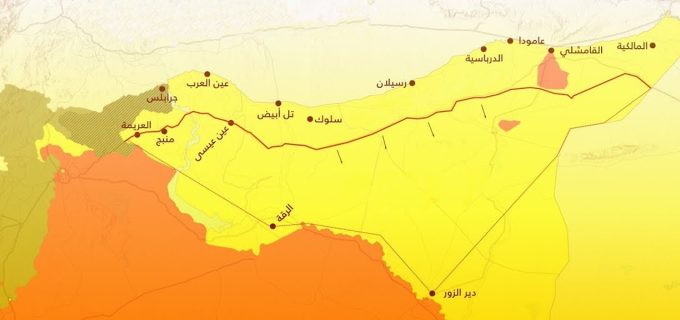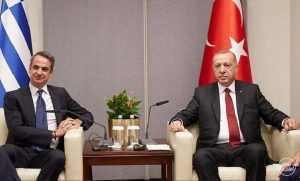On October 9, Turkey launched its third military operation (Operation Peace Spring) in the east of the Euphrates River region in northern Syria, with the aim of establishing a safe zone on its southern borders, about 30-kilometer deep within the Syrian territories, and eliminating the Kurdish People’s Protection Units (YPG). This operation has been met with strong opposition from Turkey’s NATO allies and Arab countries, in contrast to a conditional understanding of Turkey’s concerns by Russia and Iran.
Turkey has been able to sign two agreements with the United States (October 17, 2017) and Russia (October 22, 2019) separately, enabling the country to eliminate the Kurdish Units from its borders, disarm them, and establish a safe zone, faced with the challenges of application and perhaps interpretation.
This assessment of the situation discusses the dynamics of Operation Peace Spring, the measurement of the extent of achieving its objectives, and the future of the East Euphrates region after the US-Turkish and Russian-Turkish agreements.
Contexts
After Ankara’s failure to get an international (European) consensus to establish a safe zone on its borders with Syria, and despite US threats of the imposition of sanctions in case it takes military action against its Kurdish allies, Turkey took a bold decision and launched its military operation in cooperation with the Syrian National Army (formed under the revolution) under the name Operation Peace Spring, with the aim of establishing a 30-kilometer deep safe zone along the Turkish-Syrian borders.
Turkey considers the (YPG) as a branch of the Kurdistan Workers’ Party (PKK), which is classified as a terrorist entity by the United States and NATO members, and which has been fighting the Turkish government for decades. Turkey has long rejected the US’s support for the Syrian Democratic Forces (SDF), with the majority of YPG forces.
Turkey considers the control of the Kurdish units (Autonomous Administration) over northeastern Syria as a threat to its territorial integrity. This time this country seems determined to complete what it started in the operations Olive Branch and Euphrates Shield, and to achieve its objectives in establishing a safe zone despite severe international pressure. Turkey is following a military and diplomatic approach, and it has made a major breakthrough, both at the level of presence on the ground and at the diplomatic level, in achieving the objectives of Operation Peace Spring.
US President Donald Trump had decided to withdraw his troops deployed in northeastern Syria, amid opposition from many Congress members and demands to cancel his decision. Turkey resisted US sanctions imposed by U.S. President Donald Trump, who declared his readiness to destroy Turkey’s economy, but then sent his Vice President, Mike Pence, along with US Secretary of State Pompeo, to Turkey, in order to negotiate with Ankara and pressure it to stop military operations in northeast Syria. Both sides were able to reach a mutually satisfactory agreement.
Turkey’s Motives
Ankara preempted any further explanation of its military operation’s objectives by publishing the limits of the operation and its security, political and even humanitarian objectives. Turkey (despite strong international opposition) believes that no one can criticize it because these operations are based on international treaties and laws, starting from the Adana Agreement, to the UN classification of Kurdish factions as terrorist groups.
Turkey has fundamental motives for the establishment of the safe zone in northeast Syria, represented in thwarting the establishment of a Kurdish entity on its southern border that would pose a political and military threat, so as not to be an inspiration for its separatists. In addition, Western support for Kurdish Units has gone beyond fighting ISIS and has become a threat to Turkey’s national security. Turkey also aims to repatriate between one and two million refugees to the safe zone, and the Turkish government has internal goals of strengthening its public presence by reducing the number of refugees and reducing security threats.
In an attempt to eliminate fears of the military operation, Turkish President Recep Tayyip Erdoğan outlined in his speech to the Turkish parliament, on October 16, key points of Operation Peace Spring, including that Turkey in Syria does not target the Kurds or Arabs. It respects the sovereignty and unity of Syria. It is not aimed at occupying the region, but rather at securing it from terrorism. It is not against Syrian people, but against the oppressors, and it is not negotiating with the terrorists nor looking for mediators.
SDF’s position
The leaders of the Kurdish Units (SDF), which control the east of the Euphrates, were shocked by the withdrawal of US troops and the US position on the Turkish operation, after the great support they received over the past years, and after thinking that they managed to establish a state nucleus for them. This led them to conclude an agreement with Bashar al-Assad’s regime, sponsored by Russia, to deploy its troops on the Syrian-Turkish borders. SDF Commander Mazloum Kobane said that US President Donald Trump had not objected to an agreement between the Kurdish-led SDF and the Syrian government to protect Syria from the Turkish offensive.
Syrian regime’s position
The Syrian regime has had two positions on Operation Peace Spring: one populist rejecting the Operation, and the other is undeclared and seems optimistic about the results of the operation that would grant him a free control over the SDF-held areas. This has actually happened, and this is why the regime refused at the beginning of the Operation to hold discussions with SDF leaders. Actually, it said that there would be no dialogue with the traitors, in an attempt to raise its chances, but later reached an agreement under the auspices of Russia.
The regime has found an interest in the Turkish operation in weakening the Kurdish forces. Russia is playing a pivotal role, after the withdrawal of the Americans, in bringing together the Kurds and Bashar al-Assad’s regime on the one hand, and Turkey and al-Assad’s regime on the other. Media outlets reported that Russian President Vladimir Putin had contacted Bashar al-Assad during his talks with Turkish President Recep Tayyip Erdoğan, reaching an agreement to withdraw Kurdish forces at 30 km and organize joint patrols up to 10 km.
Arab positions
There have been divergent Arab positions regarding Turkey’s intervention (Operation Peace Spring) in northeast Syria, as some countries issued independent statements condemning the Operation and considering it an invasion, namely Egypt, Saudi Arabia and the UAE, while some countries understood Turkey’s position, namely Qatar and Morocco. Egypt had called for an emergency meeting of foreign ministers at the headquarters of the Arab League in Cairo, and the meeting issued a final statement condemning what it called the Turkish aggression against Syria. “Every Syrian effort confronting this aggression and defending the Syrian territory is an application of the inherent right of the principle of legitimate self-defense in accordance with Article 51 of the Charter of the United Nations,” stressed the statement. But Qatar and Somalia have had reservations.
On the popular level, despite the division between those who understand and those rejecting the Turkish Operation, popular condemnation prevailed over the official Arab positions that came up against Turkey and did not denounce in the same way the foreign Iranian, Russian, American, French and British military interventions in Syria nor the displacement and attacks the Kurdish Units carried out against the people of those areas.
After the agreements Turkey reached with the United States and Russia, the Arab countries remained silent and did not issue statements specifying their positions.
The Iranian position
Iranian positions seemed confused between their desire to eliminate US troops out of northern and eastern Syria through the Turkish military intervention, and the fear that Turkey would expand its military and political influence at the expense of Iran’s strategies in Syria. Iran has, thus, found itself far from the Turkish-Russian agreement on Syria. With severe economic sanctions, Iran seemed keen to align its relationship with Turkey following its interests with Bashar al-Assad’s regime.
There have been varied Iranian positions in the severity of their remarks on the Turkish Operation Peace Spring, which prompted Turkish President Recep Tayyip Erdoğan to ask his Iranian counterpart to silence Iranian voices condemning the operation. Iranian government Spokesman Ali Rabiei said that his country is aware of Turkey’s concern about securing its southern borders, but does not consider that military operations as the solution, expressing his country’s concern about the security of Kurds living in northern Syria.
European positions
European positions were strong towards the Turkish military Operation, on top of which France, Germany and the UK, which condemned the Operation and tried to issue a Security Council resolution condemning the Operation and discussing the sanctions that can be imposed on Turkey. Despite failing twice in the Security Council, France called the International Coalition Against Terrorism to hold a meeting, and Germany called for the establishment of a safe zone with international protection, a demand that may meet the demands of Kurdish Units to restrict the Turkish movements in northern Syria. European positions have strained their relationship with Turkey, which felt that the European position is a plot and does not influence its position.
Fighting diplomacy
The Turkish diplomacy has recorded an active presence in the preparation and management of the Operation and the dealing with international criticism against it. It has managed to resist Western pressure and sanctions and conclude important agreements with the United States and Russia, enabling it to crack the relations of Kurdish Units with Western countries and drive them away from most of its borders, if the agreements are implemented as the Turks wish. These agreements have thus restored Turkey’s upper hand in its external relations.
Under these agreements, Russia will be in charge of eliminating Kurdish Units from the Turkish borders to a 30-kilometer depth and conducting joint patrols starting from October 23, 2019 at a 10-kilometer depth in the areas of northern Syria, except for Qamishli. The city has been kept outside the Operation to avoid clashes with Syrian regime forces, according to Turkish Foreign Minister Mevlüt Çavuşoğlu.
Through the items of the agreements, Turkish demands appear to have been included, with the least human, material and temporal costs. Both agreements included the requirements of the protection of Turkish national security, through the safe area, which was applied between 120 hours under the Turkish-American agreement, and 150 hours under the Turkish-Russian agreement.
So, Turkey suspended Operation Peace Spring in order to allow the withdrawal of people’s protection Units (YPG) from the safe area.
The picture shows the control scheme under the Turkey-Russia agreement:
The central area colored by light blue for (Operation Peace Spring), dark blue color for joint patrols, brown color for areas without Kurdish Units, yellow color for areas of Kurdish Units, light blue color far left for Olive Branch and Euphrates Shield with Syrian opposition, and the gray color for the regime forces.
Terms of the Turkish Agreements
| M | Turkish-Russian agreement text |
Turkish-American agreement text
|
| Syrian Unity | The two sides renewed their commitment to
preserve Syria’s political unity and territorial integrity and protect Turkey’s national security. |
The two countries affirm their
commitment to Syria’s political unity and territorial integrity and the political process led by the United States aimed at ending the Syrian conflict in accordance with UN Security Council Resolution 2254. |
| Counter-
terrorism |
The two sides affirm their determination
to fight against terrorism in all its forms and to sabotage the separatist agendas in Syrian territory. |
Turkey and the United States are
committed to fighting ISIS activities in northeastern Syria, including coordination on detention facilities and internally displaced persons from areas previously held by ISIS, as the situation requires. |
| Both sides will take the necessary
measures to prevent the infiltration of terrorist elements. |
Turkey and the United States
agree that counter-terrorism operations should target terrorists alone, their hideouts, shelters, positions, weapons, vehicles and equipment. |
|
| Safe zone
boundaries, Regulated Mechanisms and Timeline |
Starting from 12.00 pm on October 23,
2019, Russian military police and Syrian border guards will enter the Syrian side of the Turkish-Syrian border, outside the area of Operation Peace Spring, to facilitate the exit of People’s Protection Units (YPG) elements and weapons to a depth of 30 km from the Syrian-Turkish border, which should be completed within 150 hours. At that time, joint Russian-Turkish patrols will begin in the west and east of the area of Operation Peace Spring at a depth of 10 km, with the exception of Qamishli.
|
The two sides agreed on the
continued importance of establishing a safe zone and its function of “addressing Turkey’s national security concerns,” including the re-collection of heavy weapons from the YPG, and the disruption of their fortifications and all other fighting positions. |
| The two sides reaffirm the importance of
the Adana Agreement, and Russia will facilitate the implementation of the agreement in the current circumstances. (The Adana Agreement was signed between Syria and Turkey in 1998, and gives Ankara the right to “pursue terrorists” inside Syria up to a depth of 5 km, and take the necessary security measures if its national security is jeopardized.)
|
The Turkish side will stop Operation Peace Spring in order to allow the YPG to be withdrawn from the safe area within 120 hours. Operation Peace Spring will be stopped when the withdrawal is completed.
|
|
| All elements of Kurdish Units and their
weapons will be removed from Manbij, and Tal Rifaat (west of the Euphrates). |
The Turkish Armed Forces will
primarily implement the safe area, and the two sides will increase their cooperation in all its dimensions. |
|
| A joint monitoring and verification
mechanism will be established to monitor and coordinate the implementation of this memorandum. |
Turkey and the United States
agree that conditions on the practical ground, especially Northeastern Syria, require closer coordination based on common interests. |
|
| Joint efforts will be initiated to facilitate the
safe and voluntary return of refugees. |
The two countries
reaffirm their commitment to support human life, human rights and the protection of religious and ethnic communities. |
|
| The
return of refugees and the normalization of the situation |
The Turkish side expressed its
commitment to ensure the safety and welfare of the population and of all population centers in the safe area controlled by the Turkish forces (Safe Zone), and reaffirm the utmost care in order to avoid any damage to civilians and civilian infrastructure. |
|
| The
political solution in Syria and the bilateral relations between the two Countries
|
The two sides will continue to work for
a lasting political solution to the Syrian conflict within the framework of the Astana Mechanism and will support the activities of the Constitutional Committee. |
Turkey and the United
States remain committed to protecting NATO regions and NATO populations from all threats with a solid understanding of “one for all and all for one.” |
| Once the Operation Peace Spring
is suspended, the United States agrees to suspend sanctions under the October 14, 2019 Executive Order, to prohibit property and suspend the entry of certain persons contributing to the situation in Syria. It will work and consult with the Congress to confirm progress in achieving peace and security in Syria, In accordance with Security Council Resolution 2254. |
||
| Once the Operation Peace Spring is
suspended in accordance with paragraph 11, the current sanctions shall be lifted under the said Executive Order. |
||
| The parties undertake to work
together to implement all the objectives set out in this Statement. |
It is noticeable from the terms of the agreements signed between Turkey and Russia on the one hand, and between Turkey and the United States on the other, that the first focuses on the safe area in northeastern Syria and its related issues, including the return of refugees, the fight against terrorism, the search for a political solution and avoiding tackling bilateral relations. On the other hand and in addition to the common points shared with the first agreement, special provisions in the Turkish-American agreement especially at the level of bilateral relations between the two countries emerged. These provisions predict the magnitude of the disparities and the damage caused on the level of both countries’ visions and relations over recent years.
Scenarios
The future of the eastern Euphrates region is linked to the nature of the Turkish-Russian understandings and the US position on these understandings, as well as Turkey’s vision of achieving its strategic objectives, and the extent to which limited action remains on the ground.
Scenario 1: Turkey’s establishment of a safe zone
This scenario anticipates Turkey’s successful establishment of a safe zone along its southern border, approximately 30 kilometers deep, whether by relying on its own military capabilities or by the agreements signed with the United States and Russia. These stipulate the removal of the Units from the border and areas that would help Turkey to protect its national security according to Turkish goals.
This scenario reinforces Turkey’s seriousness and ability to bear the consequences of its intervention in Syria, its resistance to international pressures supported by its military capabilities, and achievements in the field at this stage, and its experience in the previous two operations: the Olive Branch and the Euphrates Shield. This is in addition to the submission of Kurdish Units after the American betrayal and its acceptance of withdrawal from the border under the agreements signed by Turkey with the United States and Russia.
This scenario weakens the political and military complexities facing Turkey in implementing the establishment of the Safe Zone, the need for a long time to accomplish its mission and the possibilities of weak ability to withstand the repercussions at the internal and external levels.
Scenario 2: Partial success with strategic objectives
The second scenario implies that Turkey will be satisfied with what it has achieved on the ground by means of Operation Peace Spring, in addition to the withdrawal of US and Kurdish forces from its southern border. Besides, the Turkish authorities have achieved a strategic objective by thwarting the establishment of a Kurdish state on its southern border.
This scenario is based on the realization of the interests of all parties within the acceptable limits; thus, pushing the Americans to leave and weakening the Kurds serve in the interest of Turkey, Russia, and Iran as well as al-Assad regime. Consequently, the Russian role in Syria will be strengthened, and the regime forces will be able to enter north-eastern Syria for the first time since 2012, in addition to Turkey’s desire to prove that it has no ambitions in the Syrian territory, or intention to occupy the country, in order to avoid economic sanctions and destabilized relations with the other international actors.
Such scenario is likely to be realized nowadays, as it achieves strategic objectives at limited cost and help concerned parties circumvent heavy losses, though the goal of returning refugees is not achieved as planned.
Scenario 3: Safe zone creation fails
The third scenario anticipates the possibility of obstructing the implementation of Turkey’s agreements with Russia and the US, in addition to the failure of Kurds’ forces withdrawal from specific areas as agreed upon. The Kurds’ previous consent to withdraw was tactical and aimed at having the chance to arrange their situation, which may cause Turkey’s failure to achieve its objectives, and the resumption of military clashes. Thus, al-Assad forces and Iran’s militia may participate in the confrontations at a later stage.
This scenario is based on the premise that the international powers consider Turkey’s actions as a failure factor that may abort its plans, and an attempt to expand its regional influence and restore its international importance, especially in light of the proposals adopted by the European countries regarding the establishment of a safe zone with international protection in which Turkey is merely a contributor. Thus, Turkey considers that the US’s attempt to protect the SDF, and not the Turkish national security, a deliberate act of sabotage against the Turkish-Russian agreement. Interfax News quoted the Kremlin saying that: “Washington is apparently encouraging the Kurds to stay near Turkey’s border and engage the Turkish army.”
In this case, international resolutions condemning Turkey and narrowing its military and political options may be issued, which may lead to the involvement of international parties in the confrontations, albeit through agents and militias.
Such scenario weakens Turkey’s military potential, public support for the operation inside Turkey, the blows to the SDF, as well as international polarization (US and Russia) to Turkey.







